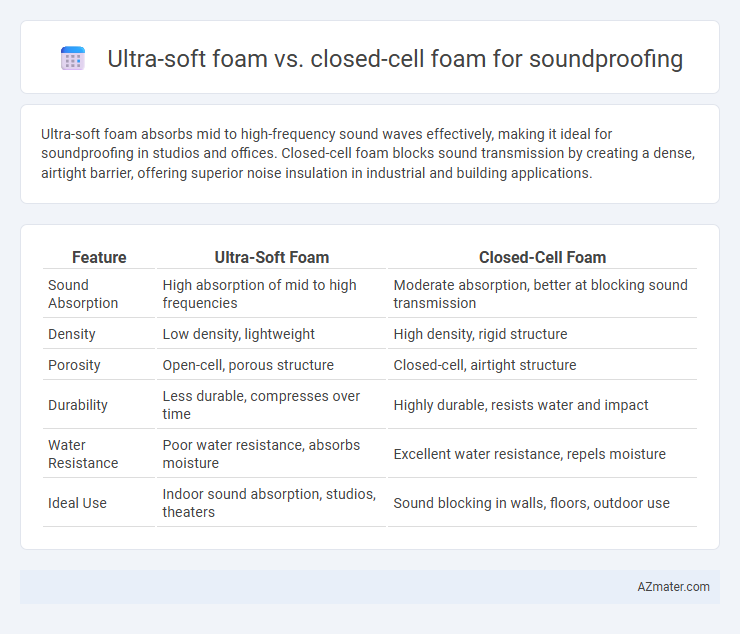Ultra-soft foam absorbs mid to high-frequency sound waves effectively, making it ideal for soundproofing in studios and offices. Closed-cell foam blocks sound transmission by creating a dense, airtight barrier, offering superior noise insulation in industrial and building applications.
Table of Comparison
| Feature | Ultra-Soft Foam | Closed-Cell Foam |
|---|---|---|
| Sound Absorption | High absorption of mid to high frequencies | Moderate absorption, better at blocking sound transmission |
| Density | Low density, lightweight | High density, rigid structure |
| Porosity | Open-cell, porous structure | Closed-cell, airtight structure |
| Durability | Less durable, compresses over time | Highly durable, resists water and impact |
| Water Resistance | Poor water resistance, absorbs moisture | Excellent water resistance, repels moisture |
| Ideal Use | Indoor sound absorption, studios, theaters | Sound blocking in walls, floors, outdoor use |
Understanding Ultra-Soft Foam for Soundproofing
Ultra-soft foam for soundproofing excels in absorbing mid to high-frequency sounds due to its open-cell structure, which dissipates sound waves and reduces echo within a space. Unlike closed-cell foam, it provides superior breathability and flexibility, making it ideal for acoustic treatments in recording studios and home theaters. Its lightweight composition also enables easier installation while maintaining effective noise control.
What Is Closed-Cell Foam?
Closed-cell foam consists of tightly packed cells that create a dense, rigid material, making it highly effective for soundproofing by blocking airborne noise and vibrations. Its impermeable structure prevents air and moisture infiltration, enhancing durability and maintaining acoustic performance over time. Compared to ultra-soft foam, closed-cell foam provides superior sound insulation and structural support in environments requiring robust noise reduction.
Key Differences: Ultra-Soft vs Closed-Cell Foam
Ultra-soft foam excels in absorbing mid to high-frequency sounds due to its porous open-cell structure, making it ideal for reducing echo and reverberation within rooms. Closed-cell foam offers superior soundproofing by blocking noise transmission with its dense, non-porous structure, effectively sealing gaps and preventing airborne sound infiltration. The key difference lies in ultra-soft foam's sound absorption capabilities versus closed-cell foam's sound blocking and insulation properties in acoustic applications.
Acoustic Performance Comparison
Ultra-soft foam offers excellent sound absorption by trapping mid to high-frequency noise due to its porous structure, making it ideal for reducing echo and reverberation in recording studios. Closed-cell foam, with its dense, non-porous composition, excels at blocking low-frequency sounds and preventing sound transmission through walls and floors. Combining both materials can optimize acoustic performance by addressing a broader range of sound frequencies in soundproofing applications.
Sound Absorption Capabilities
Ultra-soft foam excels in sound absorption due to its open-cell structure, which traps and dissipates sound waves effectively across a wide frequency range, making it ideal for reducing echo and reverberation in indoor spaces. Closed-cell foam, with its dense and impermeable structure, primarily blocks sound transmission rather than absorbing it, offering superior insulation against airborne noise but less effectiveness in absorbing ambient sound. For optimal soundproofing, ultra-soft foam is preferred when the goal is to absorb sound and improve room acoustics, while closed-cell foam serves better as a barrier to prevent sound from passing through walls or surfaces.
Installation and Application Methods
Ultra-soft foam, often used in acoustic panels, offers easy installation through adhesive backing or mounting clips, making it ideal for irregular surfaces and DIY applications. Closed-cell foam, characterized by its dense structure, requires precise cutting and securing with mechanical fasteners or specialized adhesives, suitable for walls and industrial soundproofing. Installation of closed-cell foam benefits from its moisture resistance, enabling use in environments with fluctuating humidity levels where ultra-soft foam may degrade quickly.
Durability and Longevity
Closed-cell foam outperforms ultra-soft foam in durability and longevity due to its dense, rigid structure that resists compression, moisture, and microbial growth, making it ideal for long-term soundproofing applications. Ultra-soft foam, while effective for initial sound absorption, tends to degrade faster under mechanical stress and environmental exposure. Using closed-cell foam ensures sustained acoustic performance and structural integrity over time, reducing the need for frequent replacements.
Cost Efficiency and Budget Considerations
Ultra-soft foam offers a cost-effective solution for basic sound absorption, making it ideal for budget-conscious projects with moderate noise reduction needs. Closed-cell foam provides superior soundproofing performance due to its dense structure but comes at a higher price point, impacting overall budget allocations. Evaluating the balance between material cost and acoustic effectiveness is crucial for selecting the most economical soundproofing option tailored to specific project requirements.
Best Uses for Each Foam Type
Ultra-soft foam excels in absorbing mid to high-frequency sounds, making it ideal for acoustic treatment in recording studios, vocal booths, and home theaters where sound clarity is vital. Closed-cell foam, with its dense, impermeable structure, provides superior noise blocking and moisture resistance, making it well-suited for industrial soundproofing, HVAC systems, and outdoor applications. Selecting the right foam depends on whether sound absorption or sound isolation is the priority in the environment.
Choosing the Right Foam for Your Soundproofing Needs
Ultra-soft foam excels in absorbing mid to high-frequency sound waves, making it ideal for reducing echo and improving room acoustics in studios or home theaters. Closed-cell foam provides superior sound insulation by blocking low-frequency noise and preventing sound transmission through walls due to its dense, airtight structure. Selecting the right foam depends on your specific soundproofing goals: opt for ultra-soft foam to enhance acoustic quality or closed-cell foam to effectively isolate and block external noise.

Infographic: Ultra-soft foam vs Closed-cell foam for Soundproofing
 azmater.com
azmater.com